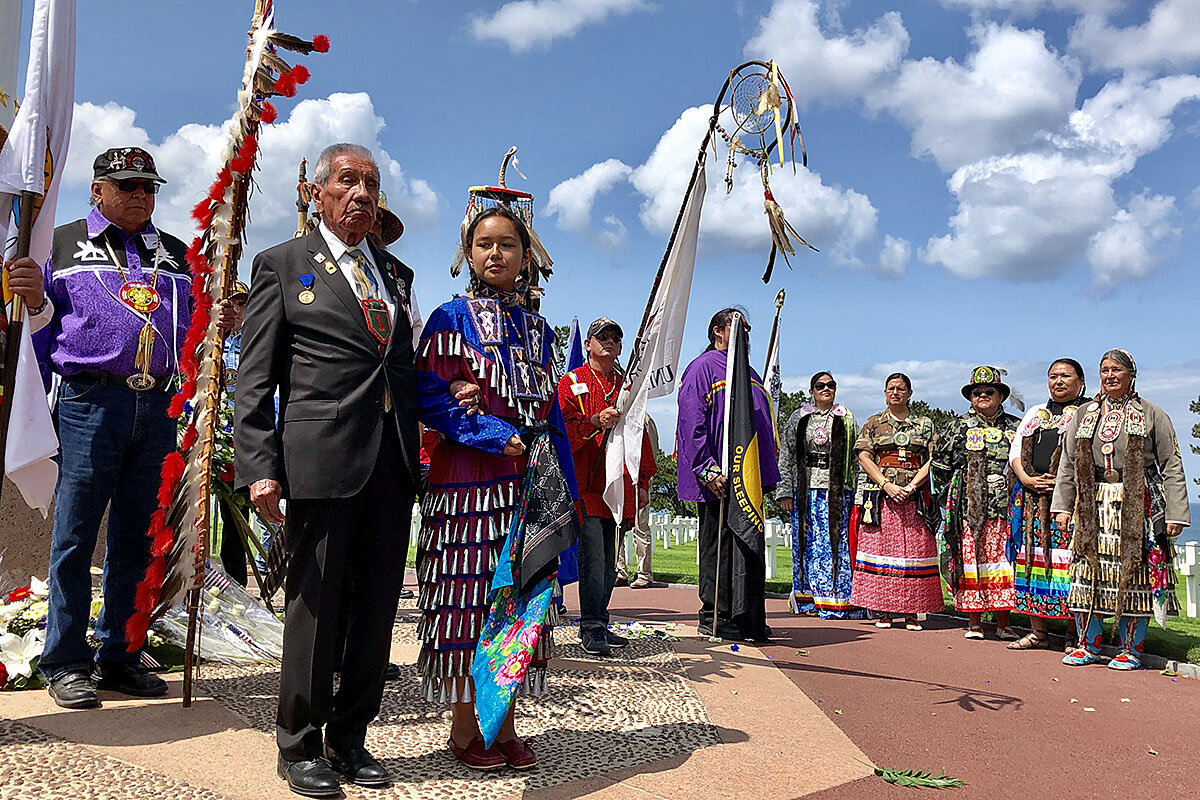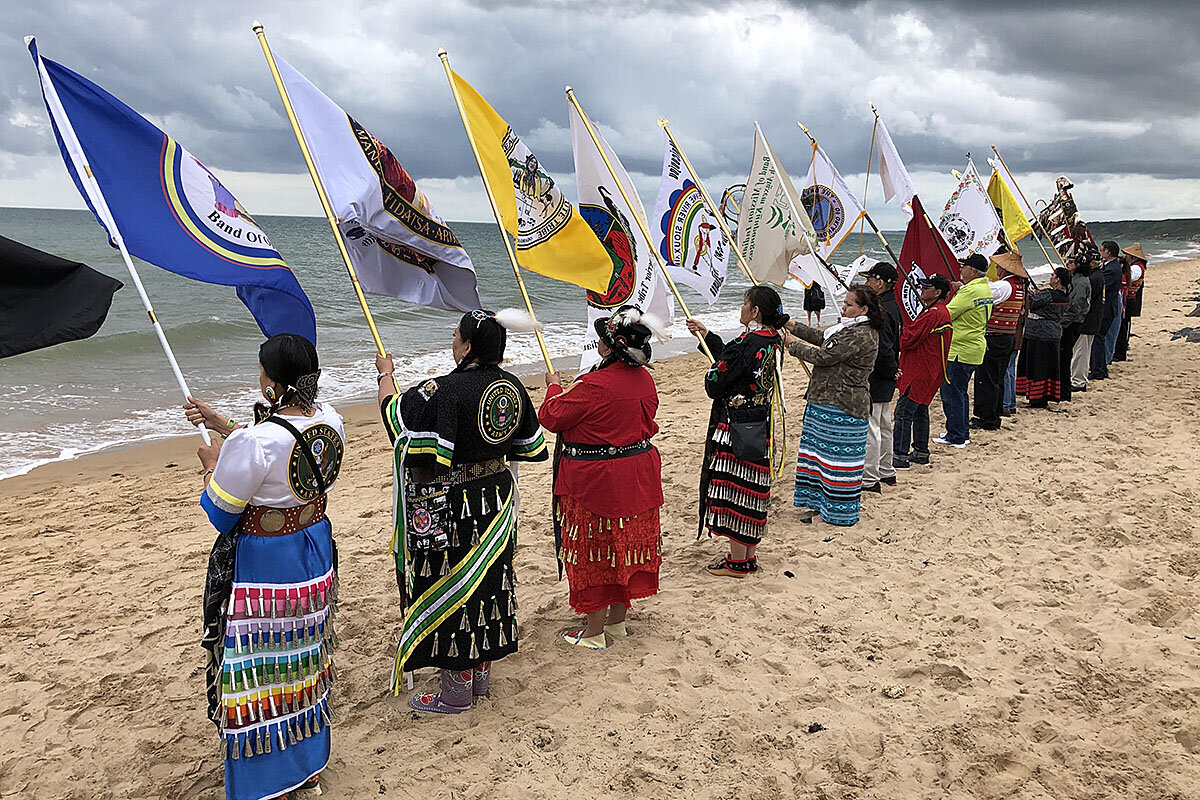The flag of the Penobscot Indian Nation flies above the low dunes at Omaha Beach in Saint-Laurent-sur-Mer. At the base of the flagpole stands a sculptured granite turtle. This monument is the focus of a tribute to the 175 Native American soldiers who struggled up this shore on D-Day 75 years ago. On Wednesday, a delegation representing numerous tribal nations gathered here for a commemorative ceremony led by Charles Norman Shay, the World War II combat veteran for whom the small memorial park is named.
“We are gathered here at the turtle monument to ensure that the great sacrifices made by Native American nations in the Second World War are no longer ignored and never forgotten,” Mr. Shay told the large crowd of observers. A 94-year-old elder of the Penobscot Indian Nation in Maine, he was among a total of some 500 American and Canadian Indian soldiers who invaded Normandy in boats, parachutes, and gliders in 1944. Mr. Shay “represents all American Indians well,” says Lanny Asepermy, a Comanche tribal historian and decorated Vietnam War veteran who is here with a delegation of Comanche code talker relatives.
French and American soldiers, including troops of the 1st Infantry Division in which Mr. Shay served, stood at attention at the Charles Shay Indian Memorial. A procession of Native Americans took position, and town Mayor Philippe Laillier spoke movingly about how Mr. Shay, as a young soldier, felt protected on D-Day under the “maternal wing” of his mother’s prayers and the spirit of the turtle’s shell.
The Penobscot veteran was one of up to 50,000 North American Indians who served in World War II. As a 19-year-old combat medic attached to an assault platoon storming Omaha Beach at dawn, Private Shay treated countless wounded soldiers, including many whom he rescued from drowning in the rising tide. For gallantry displayed on the beach that day, he was awarded the Silver Star. He served in subsequent key battles in France, Belgium, and Germany until he was captured after crossing the Rhine just weeks before peace was restored.
After his first pilgrimage back to Omaha Beach 12 years ago, Mr. Shay was inducted into the Legion of Honor by French President Nicolas Sarkozy. Since then, the Penobscot elder has committed himself to drawing attention to sacrifices made by North American Indian soldiers and their communities.
This year, close to 100 Native Americans representing more than 20 tribal communities across the U.S. have descended upon Normandy with Mr. Shay to mark the anniversary of the Allied invasion of German-occupied France. He is a key figure in a dozen Native American commemorative events being held in this week of remembrance.
At an event on Monday, the Penobscot veteran stood at the center of a ceremony at the Normandy American Cemetery and Memorial in Colleville-sur-Mer. In this 172-acre burial ground, at least 28 of the white marble crosses among more than 9,300 headstones mark the graves of Native Americans who died in the Battle of Normandy, beginning on D-Day.
For this ceremony, some 30 Native American men and women, half of whom served in more recent wars, carried spectacular eagle feather staffs or colorful flags representing their tribes. They hoisted them high as Mr. Shay, erect and solemn, read aloud the names of the Native American soldiers buried here.
Traditionally-dressed women stepped forward in beaded moccasins to perform an historic dance, as Justin Young of the Mandan, Hidatsa, and Arikara Affiliated Tribes drummed and sang. Then the group moved through the cemetery to place flowers at the 28 Native graves. Several Native American veterans performed a brief blessing at each headstone, touching it with an eagle feather and sprinkling sacred tobacco at its base.
At yet another event, Mr. Shay spoke to a crowd about freedom: “What I do care about is the price of freedom – a simple seven-letter word. Seven is a sacred number in my Penobscot culture, as it is in many Native American traditions and numerous other cultures across the globe. Liberty also has seven letters. These hallowed words represent our inherent dignity and inalienable natural right as human beings, regardless of our race, nationality, or religion. Treasure them, for these precious concepts remind us of great sacrifices and inspire us to remain forever vigilant.”
Among World War II veterans still alive, Mr. Shay is likely the last survivor of the 500 North American Indian warriors who dropped from the night sky or landed on the beaches on D-Day. Commenting on this, Penobscot tribal historian James Francis says, “Looking at the ‘Faith, Purity, Valor’ motto on the Penobscot flag I carried in the Turtle Monument ceremony, I thought how Charles especially exemplifies valor. It’s fitting that he is the last Native American veteran on hand to close the D-Day chapter of the biggest war ever fought on the planet.”
Thursday, Mr. Shay put all the praise he receives into perspective at the major event of the week, presided over by presidents Emmanuel Macron and Donald Trump with an audience of about 12,000. While he and other veterans sat on stage waiting for the presidents to arrive, a short film about D-Day played on several large screens, sending Mr. Shay’s voice across the cemetery: “I am not a hero. I just did my job. The real heroes are laying here in the cemetery. These are our heroes and we should never forget them.”






